Assessing Global Agricultural Greenhouse Gas Emissions: Key Drivers and Mitigation Strategies
Abstract
1. Introduction
2. Methods
2.1. Data Sources
2.2. Data Processing
2.3. Statistical Analysis
2.4. Model Training
3. Results
3.1. Agricultural Production
3.2. GHG Emissions
3.2.1. Emission from Crop Production
3.2.2. Emissions from Livestock Production
3.3. Influencing Factors of GHG Emissions
4. Discussion
4.1. Cultivation Emissions
4.2. Livestock Emissions
4.3. Implications and Limitations of This Study
5. Conclusions
Author Contributions
Funding
Data Availability Statement
Conflicts of Interest
Abbreviations
| GHG | Greenhouse gas |
| IPCC | Intergovernmental Panel on Climate Change |
| FAO | Food and Agriculture Organization of the United Nations |
| RFE | Recursive feature elimination |
| PCA | Principal component analysis |
| RFR | Random forest regression |
| CSA | Climate-smart agriculture |
| OECD | Organization for Economic Co-operation and Development |
| CNDML | Cattle non-dairy manure left on pasture that volatilizes (N content), kg |
| CNDMA | Cattle non-dairy manure applied to soils that leaches (N content), kg |
| AAL | All animal losses from manure treated (N content), kg |
| AAML | All animal manure left on pasture that volatilizes (N content), kg |
| AAMM | All animal manure management (manure treated, N content), kg |
| SGMA | Sheep and goat manure applied to soils (N content), kg |
| SPS | Swine/pig stocks, An |
| CBS | Cattle and buffalo stocks, An |
| CDML | Cattle dairy manure left on pasture that volatilizes (N content), kg |
| CDAE | Cattle dairy amount excreted in manure (N content), kg |
| NN | Nutrient nitrogen N (total) use per capita, kg/cap |
| MCY | Maize (corn) yield, kg/ha |
| AA | Agriculture area, 1000 ha |
| PY | Potatoes yield, kg/ha |
| PKAU | Nutrient potash K2O (total) agricultural use, t |
| NNAU | Nutrient nitrogen N (total) agricultural use, t |
| RAH | Rice area harvested, ha |
| PY | Rice yield, kg/ha |
| PPCA | Nutrient phosphate P2O5 (total) use per area of cropland, kg/ha |
| PKCA | Nutrient potash K2O (total) use per area of cropland, kg/ha |
References
- Anderegg, W.R.; Trugman, A.T.; Badgley, G.; Anderson, C.M.; Bartuska, A.; Ciais, P.; Cullenward, D.; Field, C.B.; Freeman, J.; Goetz, S.J. Climate-driven risks to the climate mitigation potential of forests. Science 2020, 368, eaaz7005. [Google Scholar] [CrossRef] [PubMed]
- Tubiello, F.N.; Salvatore, M.; Ferrara, A.F.; House, J.; Federici, S.; Rossi, S.; Biancalani, R.; Condor Golec, R.D.; Jacobs, H.; Flammini, A. The contribution of agriculture, forestry and other land use activities to global warming, 1990–2012. Glob. Change Biol. 2015, 21, 2655–2660. [Google Scholar] [CrossRef]
- FAO. Name of Database: FAOSTAT; FAO: Rome, Italy, 2024. [Google Scholar]
- Wang, Z.; Deng, X.; Bai, Y.; Chen, J.; Zheng, W. Land use structure and emission intensity at regional scale: A case study at the middle reach of the Heihe River basin. Appl. Energy 2016, 183, 1581–1593. [Google Scholar] [CrossRef]
- Smith, P.; Martino, D.; Cai, Z.; Gwary, D.; Janzen, H.; Kumar, P.; McCarl, B.; Ogle, S.; O’Mara, F.; Rice, C. Greenhouse gas mitigation in agriculture. Philos. Trans. R. Soc. B Biol. Sci. 2008, 363, 789–813. [Google Scholar] [CrossRef]
- Nayak, D.; Saetnan, E.; Cheng, K.; Wang, W.; Koslowski, F.; Cheng, Y.-F.; Zhu, W.Y.; Wang, J.-K.; Liu, J.-X.; Moran, D. Management opportunities to mitigate greenhouse gas emissions from Chinese agriculture. Agric. Ecosyst. Environ. 2015, 209, 108–124. [Google Scholar] [CrossRef]
- Tian, Y.; Zhang, J.; Li, B. Agricultural carbon emissions in China: Calculation, spatial-temporal comparison and decoupling effects. Resour. Sci. 2012, 34, 2097–2105. [Google Scholar]
- Johnson, J.M.-F.; Franzluebbers, A.J.; Weyers, S.L.; Reicosky, D.C. Agricultural opportunities to mitigate greenhouse gas emissions. Environ. Pollut. 2007, 150, 107–124. [Google Scholar] [CrossRef]
- Smith, P.; Powlson, D.S.; Smith, J.U.; Falloon, P.; Coleman, K. Meeting Europe’s climate change commitments: Quantitative estimates of the potential for carbon mitigation by agriculture. Glob. Change Biol. 2000, 6, 525–539. [Google Scholar] [CrossRef]
- Vlek, P.L.; Rodríguez-Kuhl, G.; Sommer, R. Energy use and CO2 production in tropical agriculture and means and strategies for reduction or mitigation. Environ. Dev. Sustain. 2004, 6, 213–233. [Google Scholar] [CrossRef]
- Chen, B.; He, G.; Qi, J.; Su, M.; Zhou, S.; Jiang, M. Greenhouse Gas Inventory of a Typical High-End Industrial Park in China. Sci. World J. 2013, 2013, 717054. [Google Scholar] [CrossRef]
- Lal, R. Farming systems for global issues of the 21st Century. Farming Syst. 2024, 2, 100113. [Google Scholar] [CrossRef]
- Ciais, P.; Sabine, C.; Bala, G.; Bopp, L.; Brovkin, V.; Canadell, J.; Chhabra, A.; DeFries, R.; Galloway, J.; Heimann, M. Carbon and other biogeochemical cycles. In Climate Change 2013: The Physical Science Basis. Contribution of Working Group I to the Fifth Assessment Report of the Intergovernmental Panel on Climate Change; Cambridge University Press: Cambridge, UK, 2013. [Google Scholar]
- Wu, S.; Chen, X. Research on the impact of fiscal environmental protection expenditure on agricultural carbon emissions. Front. Environ. Sci. 2023, 11, 1252787. [Google Scholar] [CrossRef]
- Balsalobre-Lorente, D.; Driha, O.M.; Bekun, F.V.; Osundina, O.A. Do agricultural activities induce carbon emissions? The BRICS experience. Environ. Sci. Pollut. Res. 2019, 26, 25218–25234. [Google Scholar] [CrossRef] [PubMed]
- Chen, X.; Shuai, C.; Wu, Y.; Zhang, Y. Analysis on the carbon emission peaks of China’s industrial, building, transport, and agricultural sectors. Sci. Total Environ. 2020, 709, 135768. [Google Scholar] [CrossRef]
- Duval, B.D.; Anderson-Teixeira, K.J.; Davis, S.C.; Keogh, C.; Long, S.P.; Parton, W.J.; DeLucia, E.H. Predicting greenhouse gas emissions and soil carbon from changing pasture to an energy crop. PLoS ONE 2013, 8, e72019. [Google Scholar] [CrossRef]
- Chen, M.; Cui, Y.; Jiang, S.; Forsell, N. Toward carbon neutrality before 2060: Trajectory and technical mitigation potential of non-CO2 greenhouse gas emissions from Chinese agriculture. J. Clean. Prod. 2022, 368, 133186. [Google Scholar] [CrossRef]
- Fellmann, T.; Witzke, P.; Weiss, F.; Van Doorslaer, B.; Drabik, D.; Huck, I.; Salputra, G.; Jansson, T.; Leip, A. Major challenges of integrating agriculture into climate change mitigation policy frameworks. Mitig. Adapt. Strateg. Glob. Change 2018, 23, 451–468. [Google Scholar] [CrossRef]
- Frank, S.; Beach, R.; Havlík, P.; Valin, H.; Herrero, M.; Mosnier, A.; Hasegawa, T.; Creason, J.; Ragnauth, S.; Obersteiner, M. Structural change as a key component for agricultural non-CO2 mitigation efforts. Nat. Commun. 2018, 9, 1060. [Google Scholar] [CrossRef]
- Li, L.; Awada, T.; Shi, Y.; Jin, V.L.; Kaiser, M. Global Greenhouse Gas Emissions from Agriculture: Pathways to Sustainable Reductions. Glob. Change Biol. 2025, 31, e70015. [Google Scholar] [CrossRef]
- Zhang, L.; Pang, J.; Chen, X.; Lu, Z. Carbon emissions, energy consumption and economic growth: Evidence from the agricultural sector of China’s main grain-producing areas. Sci. Total Environ. 2019, 665, 1017–1025. [Google Scholar] [CrossRef]
- Ehrhardt, F.; Soussana, J.F.; Bellocchi, G.; Grace, P.; McAuliffe, R.; Recous, S.; Sándor, R.; Smith, P.; Snow, V.; de Antoni Migliorati, M. Assessing uncertainties in crop and pasture ensemble model simulations of productivity and N2O emissions. Glob. Change Biol. 2018, 24, e603–e616. [Google Scholar] [CrossRef] [PubMed]
- Smith, P.; Martino, D.; Cai, Z.; Gwary, D.; Janzen, H.; Kumar, P.; McCarl, B.; Ogle, S.; O’Mara, F.; Rice, C. Policy and technological constraints to implementation of greenhouse gas mitigation options in agriculture. Agric. Ecosyst. Environ. 2007, 118, 6–28. [Google Scholar] [CrossRef]
- Kuhn, N.J.; Hu, Y.; Bloemertz, L.; He, J.; Li, H.; Greenwood, P. Conservation tillage and sustainable intensification of agriculture: Regional vs. global benefit analysis. Agric. Ecosyst. Environ. Pollut. 2016, 216, 155–165. [Google Scholar] [CrossRef]
- Kassam, A.; Friedrich, T.; Derpsch, R. Global spread of conservation agriculture. Int. J. Environ. Stud. 2019, 76, 29–51. [Google Scholar] [CrossRef]
- Bashir, M.A.; Xu, Y.; Wang, H.; Zhang, Y.; Sun, W.; Aon, M.; Zhang, X.; Rehim, A.; Liu, H. Integrated rice-crab co-culture system shows capability to reduce greenhouse gases emission and global warming potential. Aquaculture 2025, 598, 742047. [Google Scholar] [CrossRef]
- Huang, Y.; Qin, R.; Wei, H.; Chai, N.; Yang, Y.; Li, Y.; Wan, P.; Li, Y.; Zhao, W.; Lawawirojwong, S. Plastic film mulching application improves potato yields, reduces ammonia emissions, but boosts the greenhouse gas emissions in China. J. Environ. Manag. 2024, 353, 120241. [Google Scholar] [CrossRef]
- Li, H.; Dai, M.; Dai, S.; Dong, X. Current status and environment impact of direct straw return in China’s cropland–A review. Ecotoxicol. Environ. Saf. 2018, 159, 293–300. [Google Scholar] [CrossRef]
- Wang, W.; Deng, X.; Wang, Y. Changes in non-CO2 greenhouse gas emissions from livestock production, meat consumption and trade in China. Sustain. Prod. Consum. 2023, 42, 281–291. [Google Scholar] [CrossRef]
- Herrero, M.; Henderson, B.; Havlík, P.; Thornton, P.K.; Conant, R.T.; Smith, P.; Wirsenius, S.; Hristov, A.N.; Gerber, P.; Gill, M. Greenhouse gas mitigation potentials in the livestock sector. Nat. Clim. Change 2016, 6, 452–461. [Google Scholar] [CrossRef]
- Cai, Y.; Zhang, F.; Deng, X. Recoupled crop-livestock system can potentially reduce agricultural greenhouse gas emissions by over 40% in China. Environ. Impact Assess. Rev. 2025, 112, 107756. [Google Scholar] [CrossRef]
- Shi, W.; Fang, Y.R.; Chang, Y.; Xie, G.H. Toward sustainable utilization of crop straw: Greenhouse gas emissions and their reduction potential from 1950 to 2021 in China. Resour. Conserv. Recycl. 2023, 190, 106824. [Google Scholar] [CrossRef]
- Sardar, A.; Kiani, A.K.; Kuslu, Y. Does adoption of climate-smart agriculture (CSA) practices improve farmers’ crop income? Assessing the determinants and its impacts in Punjab province, Pakistan. Environ. Dev. Sustain. 2021, 23, 10119–10140. [Google Scholar] [CrossRef]
- Zakaria, A.; Alhassan, S.I.; Kuwornu, J.K.; Azumah, S.B.; Derkyi, M.A. Factors influencing the adoption of climate-smart agricultural technologies among rice farmers in northern Ghana. Earth Syst. Environ. Dev. Sustain. 2020, 4, 257–271. [Google Scholar] [CrossRef]
- Zhang, Z.; Chen, Y.-H.; Mishra, A.K.; Ni, M. Effects of agricultural subsidy policy adjustment on carbon emissions: A quasi-natural experiment in China. J. Clean. Prod. 2025, 487, 144603. [Google Scholar] [CrossRef]
- Liu, M.; Liu, H. Farmers’ adoption of agriculture green production technologies: Perceived value or policy-driven? Heliyon 2024, 10, e23925. [Google Scholar] [CrossRef]
- United States Environmental Protection Agency. Global Anthropogenic Non-CO2 Greenhouse Gas Emissions: 1990–2020; United States Environmental Protection Agency: Washington, DC, USA, 2006.
- Meijide, A.; Gruening, C.; Goded, I.; Seufert, G.; Cescatti, A. Water management reduces greenhouse gas emissions in a Mediterranean rice paddy field. Agric. Ecosyst. Environ. 2017, 238, 168–178. [Google Scholar] [CrossRef]
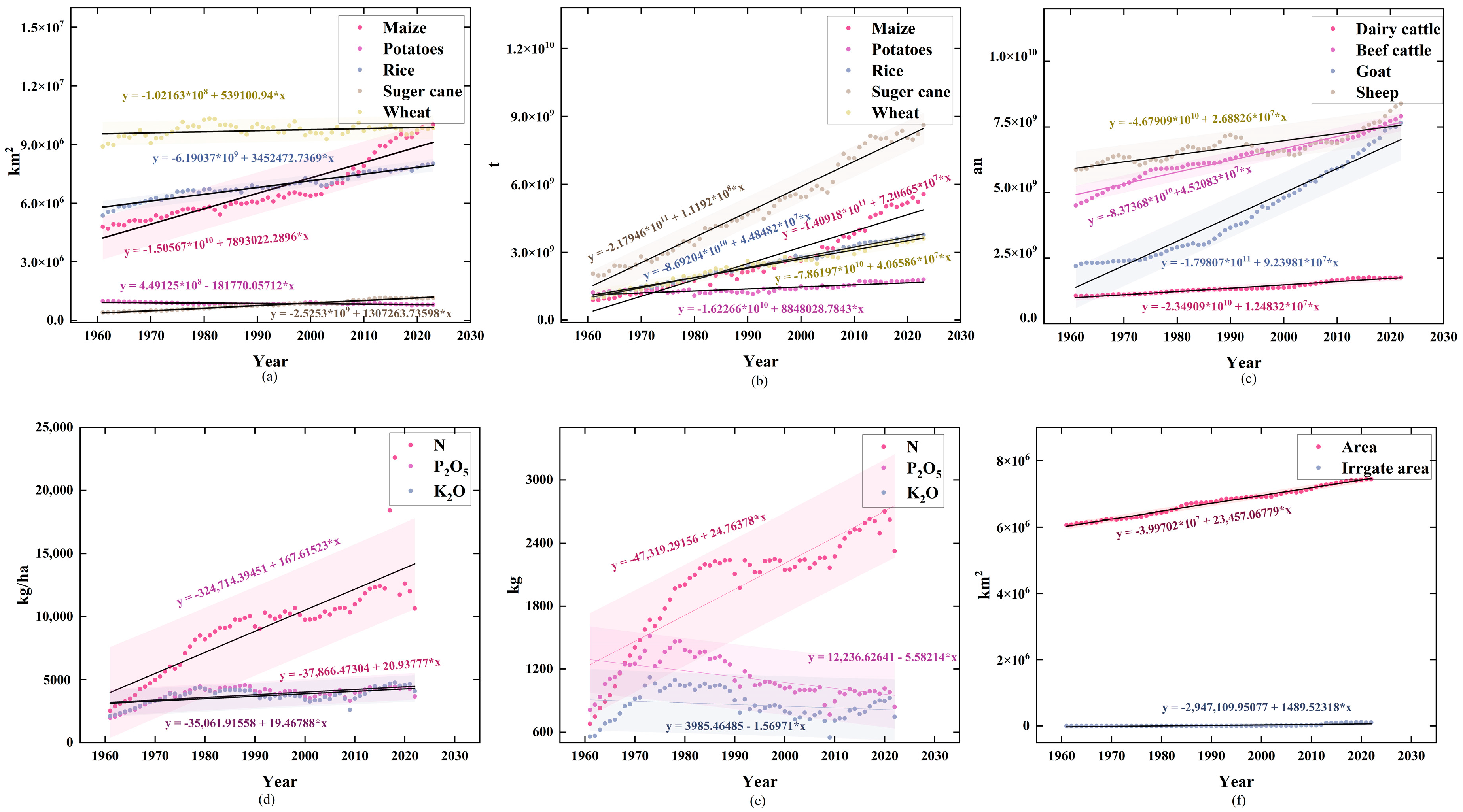
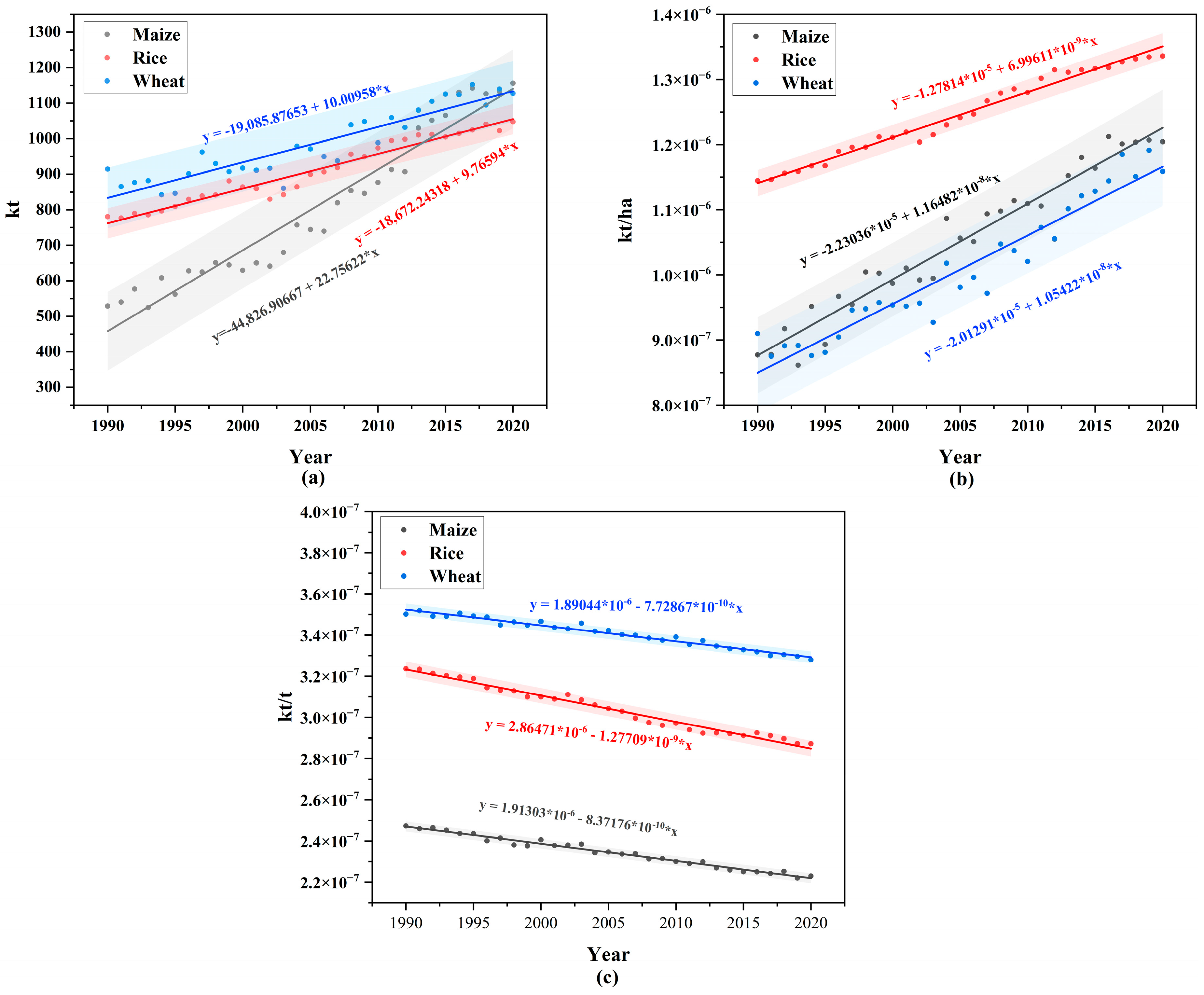
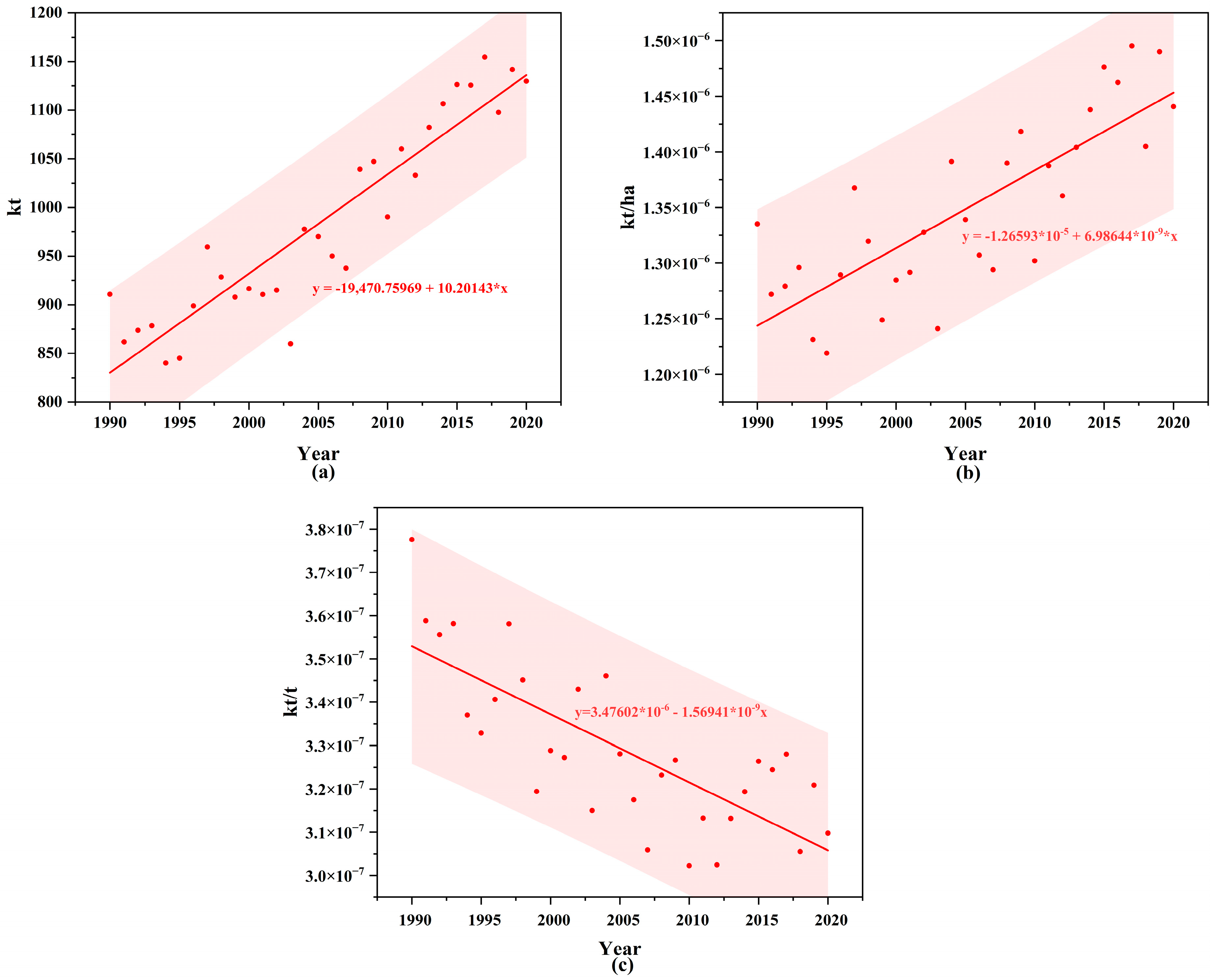
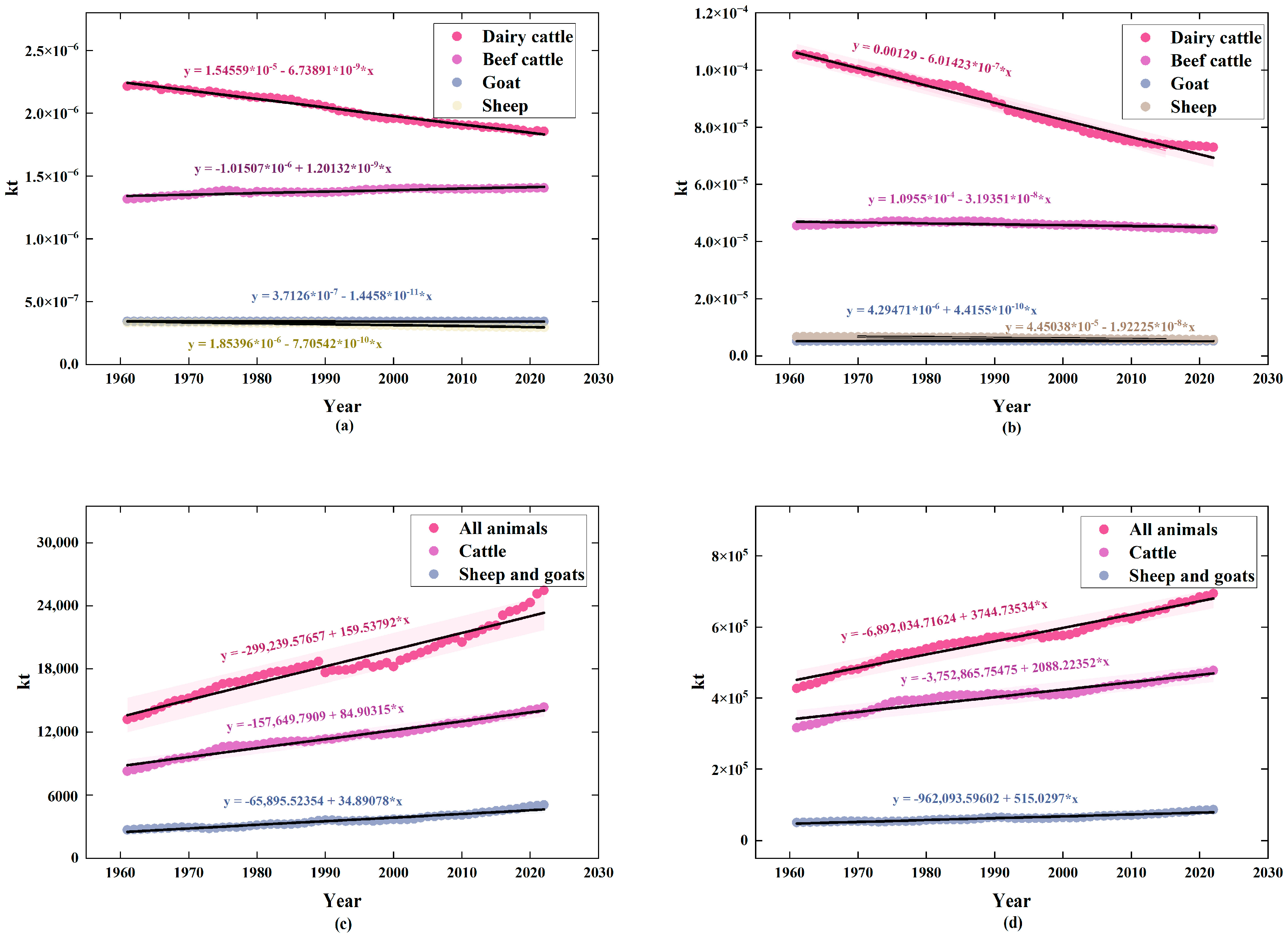
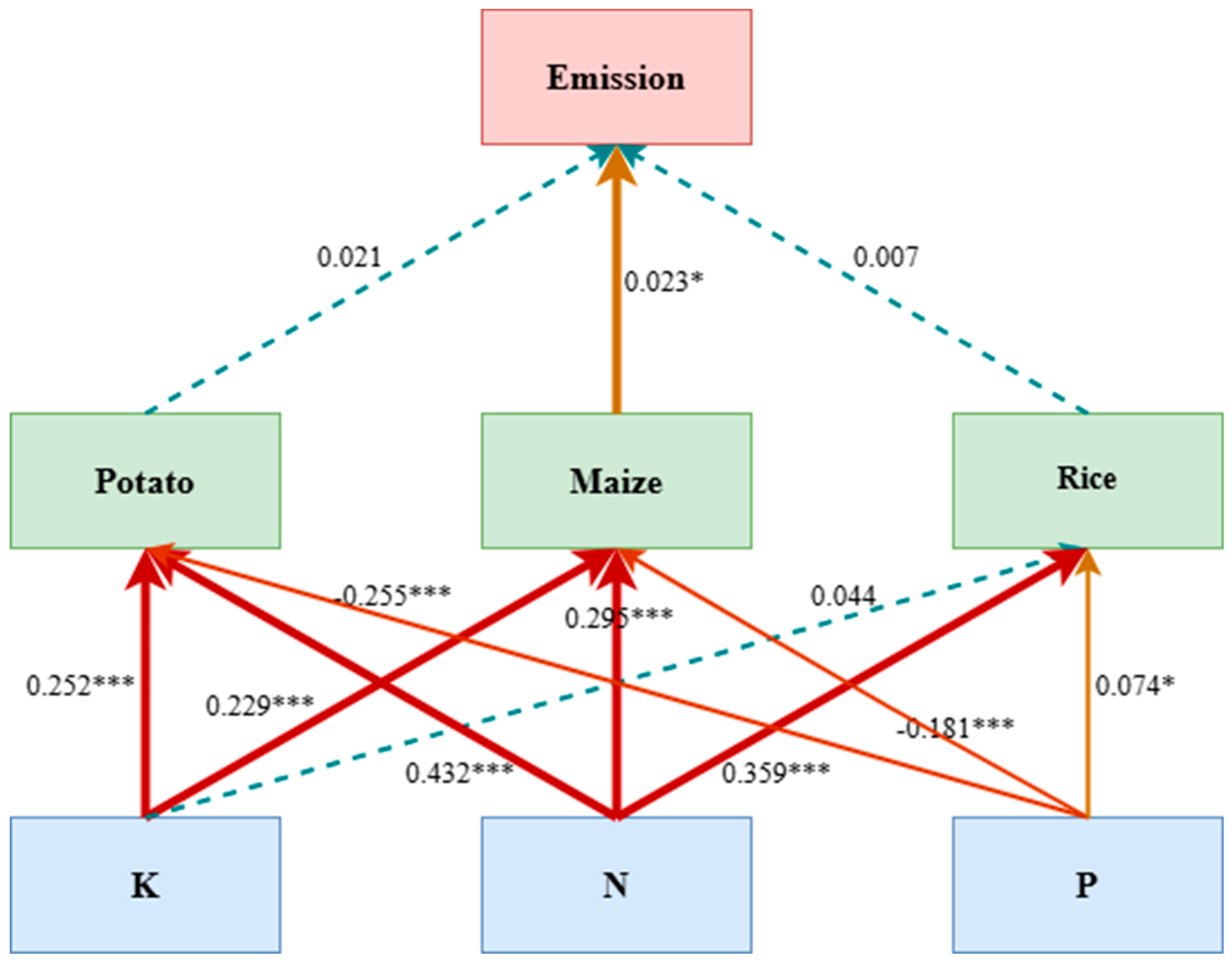
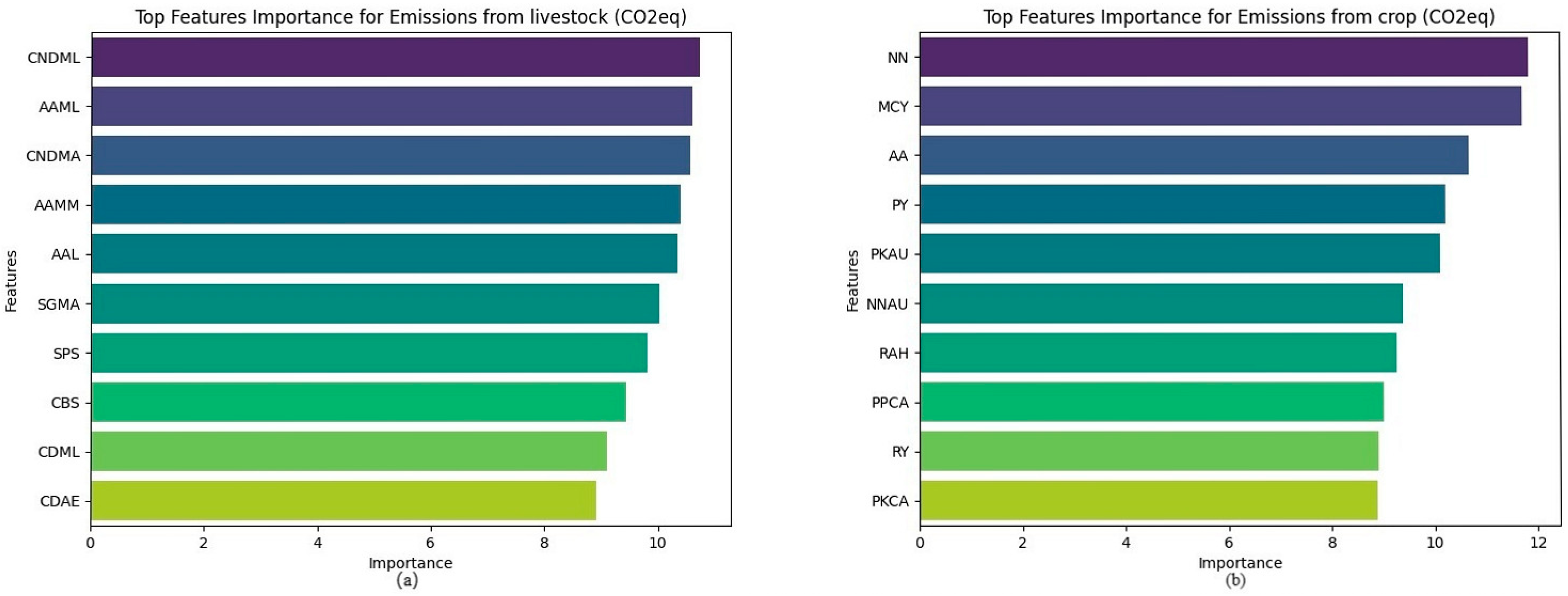
Disclaimer/Publisher’s Note: The statements, opinions and data contained in all publications are solely those of the individual author(s) and contributor(s) and not of MDPI and/or the editor(s). MDPI and/or the editor(s) disclaim responsibility for any injury to people or property resulting from any ideas, methods, instructions or products referred to in the content. |
© 2025 by the authors. Licensee MDPI, Basel, Switzerland. This article is an open access article distributed under the terms and conditions of the Creative Commons Attribution (CC BY) license (https://creativecommons.org/licenses/by/4.0/).
Share and Cite
Zhou, S.; Liu, B.; Wang, J.; Jin, D.; Zhang, H. Assessing Global Agricultural Greenhouse Gas Emissions: Key Drivers and Mitigation Strategies. Agronomy 2025, 15, 1336. https://doi.org/10.3390/agronomy15061336
Zhou S, Liu B, Wang J, Jin D, Zhang H. Assessing Global Agricultural Greenhouse Gas Emissions: Key Drivers and Mitigation Strategies. Agronomy. 2025; 15(6):1336. https://doi.org/10.3390/agronomy15061336
Chicago/Turabian StyleZhou, Shuo, Boyu Liu, Jianquan Wang, Dian Jin, and Hailin Zhang. 2025. "Assessing Global Agricultural Greenhouse Gas Emissions: Key Drivers and Mitigation Strategies" Agronomy 15, no. 6: 1336. https://doi.org/10.3390/agronomy15061336
APA StyleZhou, S., Liu, B., Wang, J., Jin, D., & Zhang, H. (2025). Assessing Global Agricultural Greenhouse Gas Emissions: Key Drivers and Mitigation Strategies. Agronomy, 15(6), 1336. https://doi.org/10.3390/agronomy15061336








